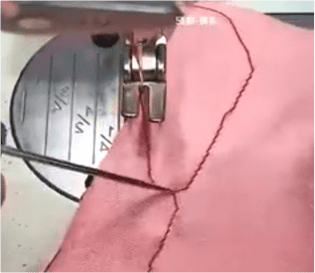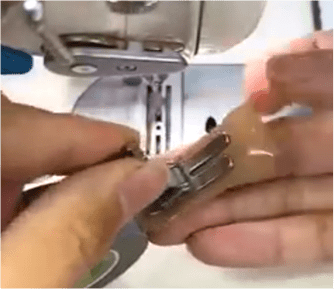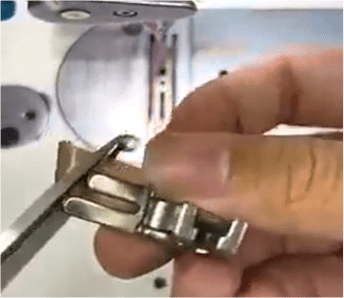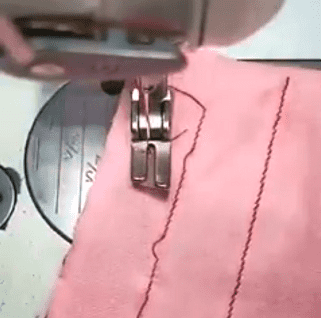Are you a knitter looking for a simple method for sewing knitted fabric? Whether you’re working on a baby blanket, sweater, or scarf, there are many different methods for joining two pieces of knit fabric. We’ve rounded up the best ways to join knit fabrics here so you can get the perfect results every time!
Start with a Good Foundation
Starting with a Good Foundation is the best way to join knit fabrics. It’s important to ensure that the material is on grain: using a ruler and a measuring tape, make sure that the fold of the fabric is parallel to the crosswise and lengthwise grain of the material. Additionally, it’s important to use pattern weights or pins to hold your fabric in place so that it doesn’t shift as you sew.
Once your fabric is prepped, you can combine two pieces with a flat seam. Using a basic straight stitch, sew along one side of the seam allowance, then backstitch at the beginning and end of your line to secure your seam. To join two pieces together in a corner, use a blanket stitch or an overcast stitch for more strength. As you sew, make sure you are not stretching or pulling on your fabric to get a neat and tidy finish.
Finally, remember that when joining knit fabrics together, using the right type of thread is key. Choose threads designed for knits, such as polyester or cotton-wrapped polyester threads for best results. With these suggestions in mind, you’ll be able to create garments with professional-looking seams!
Choose the Right Needles
Choosing the precise needle for your project is essential for successful sewing. A ballpoint needle is the best choice for knit fabrics as it has a rounded tip that won’t snag or break the delicate fibers of knit fabrics. This needle will smoothly slide between the fabric loops and make a clean stitch without damaging the fibers. Universal needles are also suitable for woven fabrics and some synthetics but aren’t ideal for knits. It’s important to ensure you select a needle size appropriate for your fabric weight; lighter materials require smaller needles, while heavier fabrics need larger needles. To pick the right sewing machine needle, consider your fabric type and weight, as well as your sewing machine model. With the right needle, you’ll easily create beautiful, even stitches!
Use the Correct Thread
The best way to join knit fabrics is by using the correct thread. The most common threads for sewing stretch knits are textured polyester or nylon threads like A&E’s Wildcat, Ansoff, Best Stretch, and many others. All-purpose thread, a cotton-wrapped polyester thread widely available for sewing, is also suitable for most applications. Choosing the right needle and using the correct seam margin and needle spacing for your application is important. The heavier or thicker your thread is, the more visible your stitches will be. Extensibility is important for threads used to join fabrics which are themselves highly extensible. All sewing threads are extensible to some degree, so finding a thread that can stretch as much as your fabric does without breaking is important. SERAFLEX sewing thread can stretch up to 65%, making it perfect for even trickier projects. To ensure that your fabric stretches and retracts with the thread, we recommend using a zigzag stitch on your sewing machine.
Know Your Stitches
Know Your Stitches is an essential part of joining knit fabrics. Joining knit fabrics requires special stitches to ensure the seams can stretch with the material. Using the right needles and pins when working with knit fabrics is important. Ballpoint or stretch needles are best to avoid ripping the stretchy fabric. Nails should also be used to hold the material in place before sewing. Finishing stitches like a zigzag stitch or other overcast stitches are also necessary to finish the raw edges of the fabric. Following these steps, you can create beautiful and lasting seams with knit fabrics.
Steps on how to join a knit fabrics
This short, straightforward tutorial will show you how to join knit fabrics. Proceed in the following manner:
The fly front is the most frightening aspect of sewing jeans for many individuals. There are various techniques for installing them, but not all of them are straightforward. We did an extensive study to determine the best technique to stitch the Denim fly front zipper.
If you’re seeking a simple method for sewing knitted fabric, this guide is for you! So, take your sewing supplies, and let’s begin!

Knit fabrics Challenge
Sewing knit fabrics together present certain difficulties.
Along the fabric, the thread won’t remain constant.
The picture illustrates where the thread will start to come loose.

Remove the Presser Foot
As the first step, remove the presser foot carefully from the machine.

Use Duct Tape on Presser Footer
Apply duct tape to the underside of the presser footer as demonstrated in the figure.

Cut the Duct Tape
Make cuts in the duct tape to match the presser footer’s contours.

Finishing touches
Finish off by reattaching the presser foot to the sewing machine and starting the stitching process fresh.

Congratulations
You successfully joined a knit fabric by following the instructions in this guide. The illustration clearly shows the distinction between the two stitches, so there is no mistaking which.
The join knit fabrics can be a great way to add style and detail to your garments. It is a relatively easy technique that can be done quickly with minimal supplies. With this video, you should have the knowledge and confidence to join knit fabrics! Whether for a dressy occasion or casual everyday wear, this garment detail will stand out in the crowd. Happy sewing!
We sincerely hope that you found this training enjoyable and helpful. Why not join a knit fabrics slit now that you know how to do it quickly? In the event that you have any queries or remarks, please do not be reluctant to leave them in the comment section that can be found below.
Fastenings for Lightweight Fabrics
Choosing the right type of fastening is important when working with lightweight fabrics. The best way to join knit fabrics without damaging the delicate material is to use elastic, thread and needle, or sew-on fasteners. For a snug fit and flexibility, elastic can be used in waistbands or cuffs. Thread and needle are best suited for hems, where you can use a zigzag stitch or stretch stitch to ensure the fabric won’t come undone. Sew-on fasteners such as buttons, zippers, snaps, and hook-and-eye closures are perfect for closing garments without causing damage or stretching out the fabric. For knit fabrics, you could use stay tape or stretch interfacing, or seam tape (stretch interfacing cut into narrow strips on a roll) to prevent wobbly seams. Remember that when it comes to lightweight fabrics, the most important thing is choosing the right type of fastening for your project!
Joining Pieces of Different Types of Fabric Together
Joining pieces of different fabrics together can greatly add detail and interest to a garment. Several methods exist, including sewing, gluing, stapling, and melting plastics. Sewing is the most common method and is particularly useful for joining knit fabrics such as jerseys. To do this, place the two pieces of cloth next to each other and stitch them together with a basic top stitch for strength. Other options include gluing the two fabrics together for a strong bond or stapling them if you need an even stronger hold. You can also use heat to melt certain plastic-type fabrics. Whichever method you choose, ensure that you securely join the two pieces of material for a quality finished product.
Attaching Zippers to Knit Garments
Attaching zippers to knit garments is a great way to give your project a polished, professional look. The key to successful zipper insertion is ensuring that the knit fabric and zipper are properly prepared before joining them together.
First, ensure your knit fabric is blocked according to how you intend to wash it. It will help keep the tension even throughout the garment. Next, gather all necessary supplies for sewing in the zipper, such as a sewing needle, thread, and pins or clips.
Once you have everything ready, use a whipstitch to attach the outside edge of the zipper to the knitting. Be sure to sew along a straight column of knit stitches for a neat finish. If you want an invisible zipper, the tech knitter’s knitting technique can be used with a picked-up I-cord edge on your knit fabric.
Finally, remember not to machine sew a zipper into your hand-knit garment, as this will cause it to ripple due to differences in tension caused by the bulk of the knitted fabric. With these easy steps, you can easily join knit fabrics with zippers for a professional finish!
Sewing Hems on Knit Fabrics
Sewing hems on knit fabrics can be daunting, but it doesn’t have to be! With the right tools, techniques, and know-how, you can easily create professional-looking hems.
When sewing hems on knit fabrics, use a sewing machine with a special stretch stitch, such as a zigzag or triple stretch stitch. A serger or overlock machine can also finish raw edges and create decorative hems.
To stabilize your knit fabric, use a lightweight fusible interfacing or iron-on hem tape before hemming. It will help keep the material from stretching out of shape while you sew.
To create a professional look with minimal effort, try using double-needle stitching or creating a topstitch finish along the edge of your hem. It will add detail and structure to the finished garment.
Finally, when working with knits, always use a ballpoint needle rather than a sharp needle to prevent skipped stitches and tearing of the fabric. Stretch thread is also recommended to help ensure that your stitches remain flexible after washing and wearing.
Thank you very much for reading!





